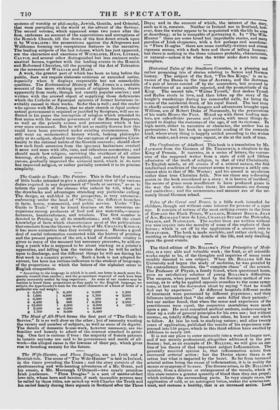particular size and weight :
a 8,500 h
b 1,600 i c 3,000 j d 4,400 Jr e 12,000 1
f 2,500 m
g 1,700 n
The Maid of All-Work forms the first part of "The Guide to Service." It is as well done as the other ; but of necessity wanting the variety and number of subjects, as well as some of its dignity. The details of domestic house-work, however necessary, are too familiar and homely to admit of the interest attached to print- ing. One fact is curious if true : the majority of female patients in lunatic asylums are said to be governesses and maids of all- work—the alleged cause is the lowness of their pay, which gives rise to brooding anxiety for the future. The Guide to Trade : The Printer. This is the first of a series of little books intended to give a plain general view of the various duties required in any department of" trade or service," so as to inform the youth of the classes who subsist by toil, what are the drawbacks and advantages attending any particular calling. The design, as unfolded in the prospectus, is very extensive ; embracing under the head of "Service," the different branches in farm, house, commercial, and public service. Under "The Guide to Trade" will be found treatises on the numerous oc- cupations among producers of food and raw materials,—manu- facturers, handicraftsmen, and retailers. The first number is devoted to Printing in all its ramifications; and, with the exact knowledge of facts which characterizes most of the publications that emanate from the literary workshop of Mr. CHARLES KNIGHT, it has more animation than they usually possess. Besides a good deal of useful information connected with the history of printing
and the present practice of the art, a kind of dramatic vitality is given to many of the meanest but necessary processes, by addres- sing a youth who is supposed to be about starting as a printer's
apprentice, and telling him the various duties he will be called upon to discharge, and the different things he will see during his
first week in a country printer's. Such a book is not adapted for extract, but here is a curious indication to the student of language, of the proportions in which the letters of the alphabet occur in English composition.
"According to the language in which it is used, one letter is much more fre- quently wanted than another ; and the proportions required of each have been pretty accurately settled by long experience. As some of our readers may be curious to know these proportions as they apply to the English language, we subjoin the type-founder's scale for the small characters of a fount of letter of a 6,400 o 8,000 v 1,200 8,000 p 1,700 w 2,000 400 q 500 x 400 800 r 6,200 y 2000, 4,000 a 8,000 z 200."
3,000 t 9,000
8,000 u 3,400


























 Previous page
Previous page